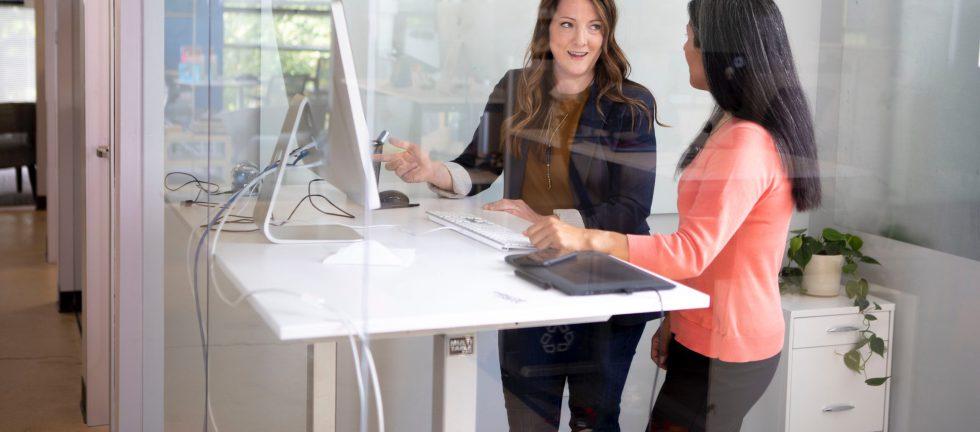I’ve been predicting for decades that, some day, everyone would arrive at work and the workstations would automatically adjust to suit their dimensions. In office environments, my prediction is coming true! Most of our clients who are purchasing new furniture are selecting desks that will adjust for seated and standing work. Research supports that this option reduces injury risk and improves productivity and work quality. Additional health benefits have been widely promoted in the media:
- Less back, neck, and shoulder discomfort
- Improved circulation
- Better alertness, focus, and attention
- Lower risk of heart disease
- Burning a few extra calories
Experts recommend a combination of sitting, standing, and moving throughout the day. Implementing regular standing breaks, along with other forms of movement and ergo adjustments, will contribute to a healthier and more comfortable work environment.
If your office is moving towards sit/stand desks, here are a few pointers to consider. (Additional office ergonomics guidance can be found in the CSA Guidelines.)
1. Accommodate all workers.
Choose furniture that accommodates the tallest and smallest workers. The top surface should go low enough for small workers to sit with the keyboard at elbow height and their feet on the floor (57.5 cm, or 22 ½ inches), and high enough for tall workers to stand and work with the keyboard at elbow height (123.7 cm, or 48 ¾ inches). Many sit/stand desks only adjust down to the height of a standard desk (28-29 inches). Only very tall people should use a computer at this height. Everyone else will need an additional keyboard tray or a higher chair and a footrest. When you search online, not all vendors specify the height range; beware!
2. Provide deep and spacious desks.
Ensure that the desk is deep enough (front to back) for tall people to tuck their legs underneath, and for everyone to push the monitor to a comfortable viewing distance. This viewing range is between 50 and 100 cm (19 ¾ – 39 ½ inches) between eyes and screen, depending on the user’s vision. An 18-inch or 24-inch deep desk will only be suitable for rare workers with short legs and short ideal viewing distances. (And no, leg length and ideal viewing distances are NOT related. 😉)
3. Train and reinforce.
Provide orientation training and ongoing awareness initiatives to encourage people to stand often for short periods of time, to strengthen and stretch the muscles they’ll be starting to use more, and to facilitate the adjustment between sitting and standing easy by marking the appropriate heights on the wall beside the desk. Encourage people to wear comfortable, supportive footwear.
We can help with this training! We offer in-person and virtual training, and a package of ongoing awareness materials to accompany the introduction of sit/stand workstations. We can also “taylor” a flip-book of instructions that you can provide with each workstation.
4. Expect and encourage a gradual transition.
Don’t be discouraged if 75% of your employees are sitting when the furniture is first introduced. A reasonable introductory goal for standing might be a total of 2 hours per day. So if you scan the office and see one in four people standing, you’re right on track!
5. Find the right balance.
Eventually, you should encourage people to stand for about half of the day. Research from the University of Waterloo suggests that the magic ratio for sitting:standing ranges between 1:1 and 1:3. That means that after you sit for 15 minutes, you should stand for 15-45 minutes. These researchers also found that 2 hours of continuous standing was sufficient to cause back discomfort, so don’t stand for too long at a time! Another Canadian research study done at the Université de Moncton found that the most preferred ratio during a 30 minute trial was 1:1, with 15 minutes of sitting and 15 minutes of standing, although a couple of study participants disliked this ratio. If you look for research, you’ll probably conclude that no one knows the exact “magic ratio”, but that’s probably because it’s a personal thing. Some days you will be more comfortable standing, and other days you will want to sit more. The main takeaway should be, “Stand up before sitting makes you uncomfortable, and then sit down before standing makes you uncomfortable.”
By implementing these tips, you can successfully integrate sit/stand furniture into your workplace. You’ll be on your way to a more productive and happier environment.
Need some help? info@taylordergo.com or 519-623-7733.


